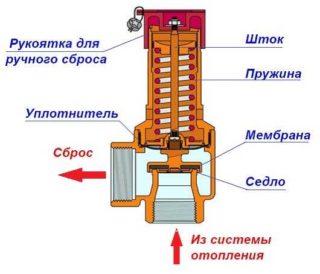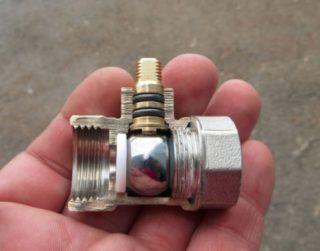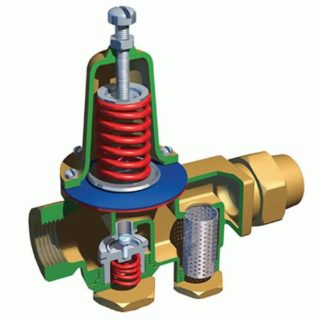Improper operation, surges and pressure drops can cause the heating system to malfunction. The consequences of situations of this type are critical: breakdown of parts, destruction of structures, a serious threat to people's lives. An ordinary safety valve in the heating system will help to avoid unsafe risks. Therefore, it is worthwhile to understand their varieties, the principle of action, the features of choice.
Operating principle
The main element of the valve is a steel spring. Due to its own elasticity, it controls the pressure on a single membrane that obscures the external outlet. The membrane is located in the saddle and is supported by a spring, the extreme part of which abuts against a metal washer. It is securely fixed to the rod, attached to a lever made of plastic.
The safety valve for heating operates as follows:
- Under normal conditions, the membrane is in the saddle, completely blocking the passage.
- As soon as the coolant overheats, it begins to expand, creates increased pressure in a closed hydraulic system. The latter is often compensated by an expansion tank.
- If the amount of water back up rises to the valve response value (most often 3 Bar), the spring is compressed, the membrane opens the passage. The boiling coolant is automatically reset until the spring closes the passage opening.
- In the event of a breakdown, excess pressure can be relieved manually. Then turn the handle at the top of the safety mechanism.
The discharge mechanism is installed on the main section near the heating unit. Recommended distance is 0.5 m.
If the boiler operates at high power (coolant temperature reaches 95 ° C), the operation of the protective device occurs cyclically. This extremely negatively affects the safety device: due to the loss of tightness, it leaks.
Types of valves

The following types of mechanisms are suitable for installation in a heating system:
Dump
According to the principle of the simplest protective device, a relief valve for heating operates: the generated gases or coolant, after reaching the excess pressure limit, press on the membrane and leave the system.
Lever and cargo
Suitable for pipes with a diameter of 0.2 m or more. In heating systems in which the heat source is a boiler, lever-load type valves are not installed. In these mechanisms, a load is used to increase the effect on the membrane. In order to determine the pressure force, at which the valve is turned on, the adjustment is carried out by changing the mass of the load.
Back
An emergency device of this kind is mounted to relieve excessive pressure. In addition, it allows the coolant to move through the pipes in only one flow, defined by the project.
Spring loaded
The most popular device used for an autonomous heating system. The device is durable, simple design: the rod is pressed by a spring. It is possible to adjust the response parameters of the device by the present regulating mechanism. The strength of the impact is determined by the degree of compression.
Ball
It has a very simple design: the hole is closed with an ordinary steel ball (weight force).The response pressure of the valve is calculated previously, it directly depends on the diameter of the hole and the weight of the ball.
Air
The purpose of such a valve is to free the system from the resulting gases, which create plugs and interfere with the proper operation of the heating system.
Valve Installation Requirements
The device for removing excessive water pressure is installed taking into account the expansion tank in the heating system. The safety valve is activated after the exhaustion of the volume of the membrane tank. The mechanism is placed on a pipeline connected to the boiler nozzle. The approximate distance is 20-30 cm.
At the same time, the following conditions must be met:
- If the valve is installed separately from the safety group, it is first necessary to mount the pressure gauge in order to control the pressure.
- Between the valve and the heating unit, valves, taps, and pumps must not be installed.
- A pipe is connected to the valve (outlet pipe) to drain excess coolant.
- The protective mechanism is recommended to be installed at the highest point of the circulation system of the thermal medium.
- The protection device must be changed after seven to eight operations due to loss of tightness.
The safety relief valve of the heating system is an important element of autonomous heating of a closed type, completely independent of the type of boiler. Even if the latter includes its own security group, experts recommend installing another one on the circuit itself.
Recommendations when choosing
Before purchasing a specific safety equipment, it is required to study in detail the technical parameters of the boiler installation. It is strongly recommended that you familiarize yourself with the manufacturers instructions in detail, which specify the boundary parameters of the equipment.
Further criteria play a major role in the selection of the required valve:
- heating unit performance;
- allowable pressure in the system for the heating power of the heating equipment;
- valve diameter.
In addition to the above, it is necessary to check that the pressure regulator of the protective mechanism has a range suitable for the parameters of the heating unit. The response pressure should exceed the operating value of the normal functioning of the system by 25-30%.
The diameter of the valve must match the size of the inlet pipe. Otherwise, under the influence of hydraulic resistance, the valve will not be able to fully perform its functions.
Not bad if the device is made of brass. It has a small coefficient of thermal expansion. This characteristic eliminates the destruction of the housing under excessive pressure. The adjustment unit is made of materials resistant to high temperature, which retain the required rigidity even in case of contact with boiling water.
Valve triggering reasons
A working protective device will never work for no reason. Each valve actuation must be examined to determine the trigger factor. There may be several. Although they are not always serious, everyone is subject to verification.
- Unstable operation or failure of the thermal control system of the heating boiler. Operations are usually frequent, water spills are plentiful.
- Problems with the expansion tank. This may be an initial setup. Hidden causes: nipple malfunction, membrane breakdown. In such cases, sudden pressure surges occur in the system, leading to short and frequent valve openings.
- The limit value of the pressure in the heating system. The protection mechanism is leaking slightly. Such manifestations are present since the accuracy of the spring device is ± 20%.To avoid such situations, you should more accurately configure the system and select the appropriate equipment.
- Valve wear. After several trips, the quality of the protective device decreases. Therefore, it is better to replace it with a new one or repair it.
- Violation of the spring. This happens over time, even in the absence of trips. Sometimes, digging occurs as a result of leakage of coolant around the stem. In such circumstances, repair or replacement cannot be avoided.
The safety valve can be checked using the red knob. If you turn it clockwise, water should appear on the normal valve. Leak stops immediately after stopping crank rotation. If this does not happen, you need to twist again. When this does not help, a replacement protective device will be required.
A safety device for regulating pressure is considered quite reliable due to design features. On the eve of the choice, first of all, you need to pay attention to the quality characteristics of the material, you should not buy a cheap product. The correct setting of the valve according to the permissible boiler pressure is very important.







